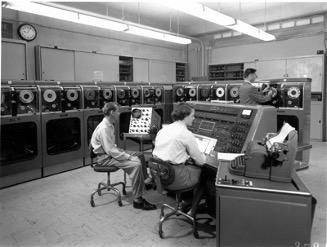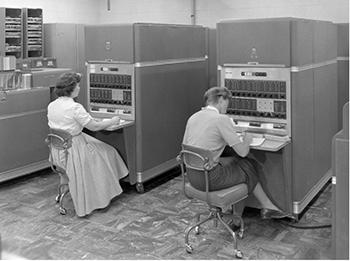Disclaimer: This article is more than two years old. Developments in science and computing happen quickly, and more up-to-date resources on this topic may be available.
In recent years, books like “Rise of the Rocket Girls” and the book-turned-movie “Hidden Figures” have brought wider attention to the women who worked as “human computers” in the 1940s and ‘50s, improving missile and rocket design and determining the trajectories that made manned space exploration feasible.
Programmable electronic computers gradually supplanted human computers over the course of the 1950s, but women found ways to remain in the new field of computing. Many women with mathematical aptitude learned to translate their abilities into machine language—and found a market that sorely needed their skills.
The Livermore Laboratory installed its first computer, a Univac 1, in 1953. But as authors G. Battimelli and G. Ciccotti have observed, Livermore physicists in the 1950s “knew what they wanted the computer to do,” but almost none could “lay down their requests in a language that the computer could understand.” To fill this gap in technical know-how, Livermore hired several women into the Theoretical Group (from which Computation emerged in 1956) as both hand computers and coders for the new electronic computers. These hires typically had degrees in physics or mathematics, but as the story of Cecilia Larsen demonstrates, the Lab has been training promising employees from its earliest days.
Larsen was one of the first group of 66 employees selected to work at the Livermore Radiation Laboratory in 1951. Though she had a master’s degree in history from Berkeley, Larsen was originally hired as a “Girl Friday” and assistant to Edward Teller. Her duties expanded dramatically in 1952 when she joined a group of engineers traveling to the Philadelphia offices of Remington Rand for training on the Univac. While in Philadelphia the Livermore contingent also poached Remington Rand’s Mary Lou Moore, who would co-design the CPU for the Livermore Advanced Research Computer, or LARC.
Larsen learned to use the machine’s earliest input device, the Unityper-1, and led a team in inputting code into the Univac. Their work was fraught with frustrations. Users could not see their output as they typed, and the temperamental Univac would regularly break down and could only be fixed with “a good, swift kick.” Larsen would remain in Computation for nearly 40 years.
While a thorough history has yet to be written of women in early computing in Livermore, their names and achievements are threaded through the archives. A list of 115 Univac personnel drawn up for the machine’s fourth ‘birthday’ includes at least 19 women and is demonstrably incomplete. Several Univac recruits, including Leota Barr, Ruth Kilby and Barbara Schell, would remain at the Lab for a decade or more. In 1970, for instance, we find Barr co-authoring (with Eleanor Reed) a report on PUFL, a FORTRAN program used by the Plowshare Program.
Edna Vienop has been featured in LLNL news stories for her collaborations with Joe Brady in writing the THEMIS code for the IBM 704, which was used to track Sputnik and predict the return of Halley’s Comet. Mary Ann Mansigh joined the Laboratory in 1955, working with computers from the Univac to the Cray I before retiring in 1994. A collaborator with physicist Berni Alder for 20 years, Mansigh has seen her career as a pioneering programmer gain recognition in recent years.
The most remarkable story of Livermore’s earliest programmers, though, may belong to Margaret Gee (1923-2013.) Born into a Chinese-American family in Berkeley, Gee grew up watching planes take off and land at the Oakland Airport. She idolized Amelia Earhart and dreamed of flying, but the obstacles were overwhelming. Instead, Gee entered the University of California at Berkeley in 1941 to study physics.
When America entered World War II, Gee left school to join the war effort. When she learned about the WASPs, or Women Airforce Service Pilots, she dropped everything to train. Gee became one of only 1,074 women, and one of only two Chinese-American women, to complete WASP training. Female pilots could not serve in combat, but as a WASP, Gee ferried new aircraft to bases and helped train male Army fighter pilots in simulated aerial combat—WASPs towed fabric targets that gunnery trainees shot at with live ammunition. Gee noted co-piloting a B-17 “Flying Fortress” bomber as a particular honor, but “the most fun, of course, were the open cockpit biplanes that did acrobatics.”
When the WASP program was disbanded in 1944, Gee returned to Berkeley, eventually earning a master’s degree in physics. In 1958, Gee joined Livermore’s Theoretical Division, initially working with Bill Schultz on design codes for the IBM 704 using FORTRAN. Both the machine and the language were completely new to her.
As Gee remembered, “We worked night and day. I commuted from Berkeley, I never moved to Livermore but I would spend nights out here. They had dormitories at that time. We went to the machines directly to program our calculations.” Gee would remain at the Lab until 1988. In 2009, she joined more than 200 surviving WASPs at the U.S. Capitol to receive the Congressional Medal of Honor.
The women profiled here faced daunting barriers—first to earning degrees in the sciences, then to finding work in their field. A range of pressures, from low pay to unequal treatment to the expectation that women would retire if they became mothers, further winnowed the field. In retrospective interviews, Larsen, Mansigh and Vienop described considerate treatment at the Lab but noted receiving lower wages and smaller raises than men in equivalent positions. Vienop recalled being told, “you’re doing great work, but […] we have lots of men with families. And we feel they deserve the higher pay.” Mansigh also observed that women might be hired, but they seldom reached supervisory positions.
Today, 70 years since the Univac-1 arrived in Livermore, women have made significant inroads in computing and STEM more broadly, but much work remains before parity is reached. But as the women in Livermore’s first decade of computing demonstrate, the drive to contribute and achieve has been there from the very start.
—Caitlin Silberman, LLNL archivist



